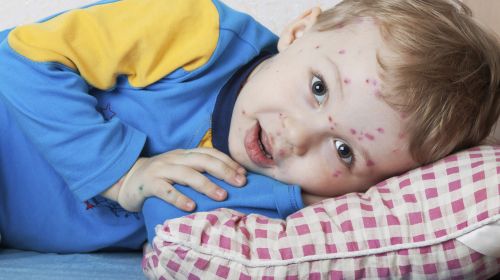Hand, foot and mouth disease (HFMK) is a viral infection that is common in children under the age of ten, but adults can also be affected. The disease is very contagious and can be recognized by typical symptoms.
- Hand, foot and mouth disease usually affects (young) children, but babies and adults can also become infected.
- © iStock.com/lolostock
Hand-foot-mouth disease, also known as hand-foot-mouth rash or false foot-and-mouth disease, affects an estimated 80,000 to 140,000 people in Germany every year. These are mostly children. The HKMS got its name from the affected areas of the disease. The disease is usually harmless, but can be dangerous for pregnant women and newborn babies. Hand, foot and mouth disease occurs year-round, but the disease increases in late summer and autumn. Certain enteroviruses are carriers.
Article content at a glance:
Cause and routes of infection
The cause of hand-foot-mouth disease are viruses, more precisely enteroviruses of group A. These include the Coxsackie A viruses typical of the disease. Humans are the only carriers of the disease, although it is often associated with foot-and-mouth disease. However, the two diseases have nothing to do with each other.
Hand, foot and mouth disease is transmitted from person to person through body fluids. Stool is also infectious. Because the disease is highly contagious, it often spreads quickly. One of the main ways of transmission is shaking hands. The time from infection to outbreak (incubation period) is usually three to ten days for HFMK, but it can vary within a range of one to 30 days.
How long has hand, foot and mouth disease been contagious?
In the first week of the disease, the person is highly infectious, which means that they can easily infect other people through saliva, secretions or stool. In particular, the secretions from the vesicles that form promote the spread of the disease. Since the viruses can be detected in the stool for a few weeks after the symptoms have subsided, the infected person remains contagious for a long time. Mostly children are affected, whereby adults are often carriers of the disease, although they show no symptoms (asymptomatic course). Over 80 percent of infections are asymptomatic.
Children can go back to daycare and kindergarten or adults can go back to work when the symptoms have subsided and the blisters have dried out. Then the most contagious phase is over.
Prevent infection of pregnant women and newborns
Since newborns can develop severe hand-foot-mouth disease, especially in the first two weeks of life, infection should be avoided at all costs. Women in the last trimester of pregnancy should therefore also be particularly careful and avoid contact with sick people. The disease itself usually runs without symptoms or complications for the unborn child during pregnancy, but can be passed on to the child at birth.
Hand, foot, and mouth disease: typical symptoms
In the first few days of infection with hand, foot and mouth disease, there is usually a fever and sore throat, as well as decreased appetite and possibly nausea. One to two days after the onset of the fever, rashes usually appear on the tongue, gums and oral mucosa. The rash can be seen as small, red spots that form blisters and are often very painful. Within the next one to two days, a rash in the form of red spots forms, especially on the palms of the hands and soles of the feet, which is usually not accompanied by severe itching. Blisters can also form here.
-
Baby with a typical rash on the foot.
© iStock.com/Joel Carillet
Duration of symptoms
Almost all sick children experience a mild course in which the symptoms disappear again within five to seven days. As a rule, the hand, foot and mouth disease is over after seven to ten days at the latest without complications.
Atypical course
If the course is atypical, the rash can appear on the buttocks, genital area, knees and elbows and be accompanied by severe itching. In rare cases, fingernails and toenails may fall out within four weeks of the illness. Very rare complications are meningitis (meningitis) or encephalitis (encephalitis) and paralysis (paresis).
How is hand, foot and mouth disease diagnosed?
If hand, foot and mouth disease is suspected, a doctor should be consulted. Since the hand and foot disease usually shows the typical course, no further diagnosis is usually necessary for the doctor. If it is necessary, evidence of the enteroviruses from a stool sample, a throat swab or the contents of a vesicle will be obtained in the laboratory.
Treatment of hand, foot and mouth disease
There is no therapy available to treat the viruses that cause hand, foot and mouth disease. The disease usually heals on its own within a few days.
Symptomatic treatment for the symptoms can be helpful. Antipyretic medication can help, or remedies for any itchiness that may be present. Affected children should drink plenty of water or tea. On the other hand, hot and spicy food should be avoided. Children with acute symptoms should never go to a care facility, but rather stay at home in bed – also because of the risk of infection.
Prevent hand, foot and mouth disease
There is currently no vaccination against hand, foot and mouth disease in Germany. However, a lot can be done to prevent infection with hand, foot and mouth disease. The main focus here is on hygiene measures:
Good hand hygiene: Especially after going to the toilet, changing diapers, blowing your nose, coughing or sneezing, hands should be washed thoroughly and with soap for at least 30 seconds.
No close contact with sick children or adults: Kissing and hugging are taboo, as is sharing dishes and cutlery. Thoroughly clean doorknobs and toilets while a family member is sick.
If the hygiene measures are observed, an infection and thus the further spread of the hand-foot-mouth disease can be well contained.




